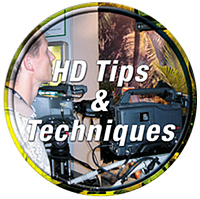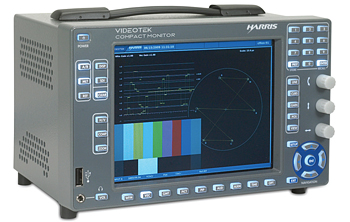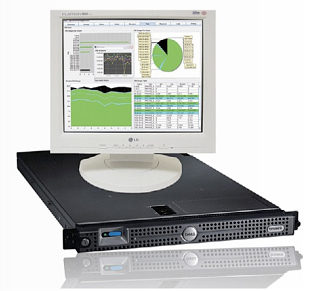Test & Measurement Goes End to End

ALEXANDRIA, VA
There once was a time when the process of testing and measuring signals was straightforward.
At the studio and control room end, you needed just a waveform monitor and vectorscope to keep an eye on signals, making adjustments so that the signal met long-established parameters. At the transmitter, you pretty much needed to check forward and reflected power, as well as internal measurements provided on the transmitter's control panel.
Things are quite different in the digital world. Do you know if your transmitter's MPEG encoder is causing jitter? Can you tell if the cellphone video the news director wants to run has the right color gamut?
Meanwhile, the ability to view signal measurements has moved out of dedicated devices and into video monitors, where both the images and waveforms can be viewed together.
"Both on-screen measurement devices and the traditional standalone scope package each have their place," said Paul Keller, product manager for test & measurement for Harris Corp. "With the large amount of data contained in today's SDI signals, the on-screen display device with a large monitor makes it easier to keep tabs on multiple parameters. The standalone scope package is best suited where space is at a premium, or portability is required, such as camera shading and field production."
Harris, which manufactures Videotek test and measurement equipment, has a variety of products for on-screen and standalone applications. The company's lower-cost Compact Monitor Series is available in on-screen and standalone versions.
"With the Compact Monitor Series, you can start with SD and move up to HD or 3 Gbps with a software key," Keller said. "[It has] battery options for field use and the ability to view an analog reference waveform."
NEW DEVICES, NEW METHODS

The Harris Videotek CMN-91 can be upgraded to 3Gbps capability with a software key. The introduction of HD meant that new devices and new methods were needed to maintain signal quality. An initial problem was that content creators weren't sure which HD format was going to be used for production and which would be used for distribution.
"In order to deliver these high resolution video formats to end viewers with the best possible video quality, content creators have to adopt a common high-frame-rate, high-resolution master format before their content undergoes compression and preparation for distribution," said Richard Duvall, senior marketing manager for video test at Tektronix. "For this reason, 1080p [50 or 59.94Hz] formats with 3G-SDI transport [Level A or Level B] has increasingly been chosen by many content creators for the format and video transport technology."
One of Tektronix's recommended products for 1080p signal integrity monitoring is the WFM8300 SD/HD/3G-SDI waveform monitor.
"Engineers installing facility infrastructure, troubleshooting difficult problems, or trying to confirm all the angles of being broadcast-legal really need more than a waveform monitor," Duvall said. "The WFM8300 is more like a 'waveform analyzer' and has been optimized for several applications including cable length measurements, signal integrity (including eye pattern and jitter analysis) on SD, HD and 3G-SDI, as well as verifying data in the ancillary data fields. This is where AFD, closed captioning and Dolby audio metadata resides, so analyzing this protocol and data is critical."
If you need traditional waveform and vectorscope monitoring but want flexibility, the Hamlet VidScope-vx is a test instrument in a USB flash drive. Software on the flash drive provides real-time or automatic monitoring tools, including waveform, vectorscope and color gamut error checking and logging. The Windows application provides a video monitor as well as measurement displays—all you need is a computer in which to plug the flash drive.
What if you need two HD-SDI signals monitored simultaneously in a single location? The LV 7380 from Leader Instruments is a rasterizer that can display two simultaneous feeds on a single computer monitor. The LV 7380 can grab screen shots of the measurement displays and save them to a USB flash drive.
MPEG CHALLENGES
Once video and audio signals head to the transmitter as MPEG-2 signals, new measurement challenges are faced. The StreamScope from Triveni Digital has been a popular tool for broadcasters to monitor and analyze their MPEG data in order to maintain signal integrity at the transmitter.
With the switch from analog to digital broadcasting, demonstrating that your plant is clean may be essential to your station's carriage agreement.

StreamScope from Triveni Digital analyzes MPEG-2 data to maintain signal integrity. "The importance of DTV carriage auditing is often overlooked," said Ralph Bachofen, vice president of sales and head of marketing at Triveni Digital. "Broadcasters that use the StreamScope family to monitor their transport streams can perform comparisons to ensure that the service they provide retains its image quality, even as it is delivered through a cable plant, satellite operator, or other downstream infrastructure."
Another approach to monitoring MPEG streams is offered by Sencore, which markets the DekTec DTC-350 VisualMPEG Pro software. Running on a Windows-based PC, DTC-350 software provides analysis, quality measurements and error logging of MPEG data streams.
Now that interest is growing in 3DTV, Rohde & Schwarz has developed an analyzer to test 3D displays (both consumer and professional) for their image quality. The Rohde & Schwarz DVSG outputs uncompressed video signals via an HDMI interface and supports the formats used for 3D TV transmissions. Instead of static images, the R&S DVSG provides long, moving sequences that allow the displays of the new 3D generation to be subjectively assessed.
The DVStation product line from Pixelmetrix is a suite of products that enable television operators to manage overall broadcast quality, using probes that connect to virtually any kind of RF, serial or IP interface. Engineers can get complete visibility into the signal as content moves down the transmission chain.
"Budgets and staffing are spread so thin, yet operators are challenged with offering more channels across multiple locations," said Danny Wilson, CEO of Pixelmetrix. "With advances in encoding, transport and modulation technologies, along with the incessant complications coming from the introduction of IT technology into the broadcast domain, exactly pinpointing a problem in all of that mess is more difficult than it has ever been."
Once the signal gets to the user, it's someone else's problem… right? If you are a content provider and want to be sure that viewers are seeing the signal that you are supplying, Pixelmetrix has a way to check signals from the viewer's perspective, called the Electronic Couch Potato (ECP).
"Sitting after a set-top box, operators are now able to scan through channels and identify errors or audio/video problems not only across the entire screen area but within user-defined regions as well," Wilson said. "That means that the ECP can be used for applications such as parental-control confirmation, channel-tiering verification and automated VOD testing, among others."
From camera to customer, there are ways to test, measure, calibrate and confirm that the signals you supply are delivered cleanly from end to end. As the television industry has evolved and grown, so has the equipment designed to keep signals clean.
Get the TV Tech Newsletter
The professional video industry's #1 source for news, trends and product and tech information. Sign up below.
Bob Kovacs is the former Technology Editor for TV Tech and editor of Government Video. He is a long-time video engineer and writer, who now works as a video producer for a government agency. In 2020, Kovacs won several awards as the editor and co-producer of the short film "Rendezvous."

